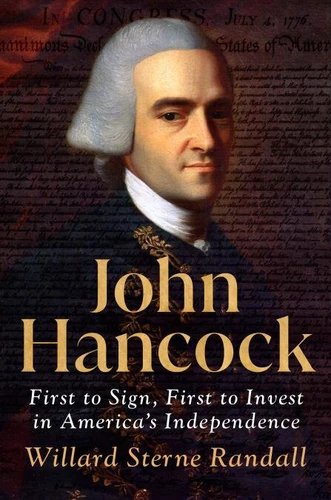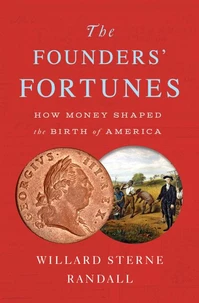John Hancock. First to Sign, First to Invest in America's Independence
Par :Formats :
Disponible dans votre compte client Decitre ou Furet du Nord dès validation de votre commande. Le format ePub protégé est :
- Compatible avec une lecture sur My Vivlio (smartphone, tablette, ordinateur)
- Compatible avec une lecture sur liseuses Vivlio
- Pour les liseuses autres que Vivlio, vous devez utiliser le logiciel Adobe Digital Edition. Non compatible avec la lecture sur les liseuses Kindle, Remarkable et Sony
- Non compatible avec un achat hors France métropolitaine
 , qui est-ce ?
, qui est-ce ?Notre partenaire de plateforme de lecture numérique où vous retrouverez l'ensemble de vos ebooks gratuitement
Pour en savoir plus sur nos ebooks, consultez notre aide en ligne ici
- Nombre de pages288
- FormatePub
- ISBN978-0-593-47215-6
- EAN9780593472156
- Date de parution10/06/2025
- Protection num.Adobe DRM
- Taille16 Mo
- Infos supplémentairesepub
- ÉditeurDutton
Résumé
A compelling, intimate portrait of John Hancock, going beyond the flamboyant signature to reveal the pivotal role that he had in the American RevolutionA contemporary of Samuel Adams, John Adams, George Washington, and the Marquis de Lafayette, Hancock had a list of contacts that read like a who's who of the American Revolution. But shockingly little has been written about Hancock himself. John Hancock tells the story of a man who deserves far more credit for his contribution to the American Revolution than he previously received-and award-winning scholar Willard Sterne Randall is determined to give him his due at last.
Born into relatively modest means, Hancock was sent to live with his wealthy uncle and aunt as a child. The couple raised him as their own and prepared him to take over the family company. A remarkably successful businessman, Hancock got involved in politics in the mid-1760s. He quickly rose in the ranks, eventually serving as the president of the Continental Congress and the first governor of Massachusetts.
John Hancock details all of the major moments in the Revolution, from the Boston Tea Party to the battles of Lexington and Concord to the signing of the Declaration of Independence. Hancock's actions fundamentally altered each of these events-and ultimately the course of the United States-in ways never taught in the history books. Randall also dives into lesser-known parts of Hancock's life with nuance and compassion, including his education and controversial work with Harvard; his long courtship and complicated marriage to Dorothy Quincy; and his close relationship and eventual bitter rivalry with Samuel Adams.
John Hancock enjoyed great popularity in Massachusetts during the Revolution, but he left behind few personal writings, making it hard to tell his story. Through extensive research, Randall aims to restore Hancock to his rightful place, celebrated for his achievements as one of our Founding Fathers at last.
Born into relatively modest means, Hancock was sent to live with his wealthy uncle and aunt as a child. The couple raised him as their own and prepared him to take over the family company. A remarkably successful businessman, Hancock got involved in politics in the mid-1760s. He quickly rose in the ranks, eventually serving as the president of the Continental Congress and the first governor of Massachusetts.
John Hancock details all of the major moments in the Revolution, from the Boston Tea Party to the battles of Lexington and Concord to the signing of the Declaration of Independence. Hancock's actions fundamentally altered each of these events-and ultimately the course of the United States-in ways never taught in the history books. Randall also dives into lesser-known parts of Hancock's life with nuance and compassion, including his education and controversial work with Harvard; his long courtship and complicated marriage to Dorothy Quincy; and his close relationship and eventual bitter rivalry with Samuel Adams.
John Hancock enjoyed great popularity in Massachusetts during the Revolution, but he left behind few personal writings, making it hard to tell his story. Through extensive research, Randall aims to restore Hancock to his rightful place, celebrated for his achievements as one of our Founding Fathers at last.
A compelling, intimate portrait of John Hancock, going beyond the flamboyant signature to reveal the pivotal role that he had in the American RevolutionA contemporary of Samuel Adams, John Adams, George Washington, and the Marquis de Lafayette, Hancock had a list of contacts that read like a who's who of the American Revolution. But shockingly little has been written about Hancock himself. John Hancock tells the story of a man who deserves far more credit for his contribution to the American Revolution than he previously received-and award-winning scholar Willard Sterne Randall is determined to give him his due at last.
Born into relatively modest means, Hancock was sent to live with his wealthy uncle and aunt as a child. The couple raised him as their own and prepared him to take over the family company. A remarkably successful businessman, Hancock got involved in politics in the mid-1760s. He quickly rose in the ranks, eventually serving as the president of the Continental Congress and the first governor of Massachusetts.
John Hancock details all of the major moments in the Revolution, from the Boston Tea Party to the battles of Lexington and Concord to the signing of the Declaration of Independence. Hancock's actions fundamentally altered each of these events-and ultimately the course of the United States-in ways never taught in the history books. Randall also dives into lesser-known parts of Hancock's life with nuance and compassion, including his education and controversial work with Harvard; his long courtship and complicated marriage to Dorothy Quincy; and his close relationship and eventual bitter rivalry with Samuel Adams.
John Hancock enjoyed great popularity in Massachusetts during the Revolution, but he left behind few personal writings, making it hard to tell his story. Through extensive research, Randall aims to restore Hancock to his rightful place, celebrated for his achievements as one of our Founding Fathers at last.
Born into relatively modest means, Hancock was sent to live with his wealthy uncle and aunt as a child. The couple raised him as their own and prepared him to take over the family company. A remarkably successful businessman, Hancock got involved in politics in the mid-1760s. He quickly rose in the ranks, eventually serving as the president of the Continental Congress and the first governor of Massachusetts.
John Hancock details all of the major moments in the Revolution, from the Boston Tea Party to the battles of Lexington and Concord to the signing of the Declaration of Independence. Hancock's actions fundamentally altered each of these events-and ultimately the course of the United States-in ways never taught in the history books. Randall also dives into lesser-known parts of Hancock's life with nuance and compassion, including his education and controversial work with Harvard; his long courtship and complicated marriage to Dorothy Quincy; and his close relationship and eventual bitter rivalry with Samuel Adams.
John Hancock enjoyed great popularity in Massachusetts during the Revolution, but he left behind few personal writings, making it hard to tell his story. Through extensive research, Randall aims to restore Hancock to his rightful place, celebrated for his achievements as one of our Founding Fathers at last.




